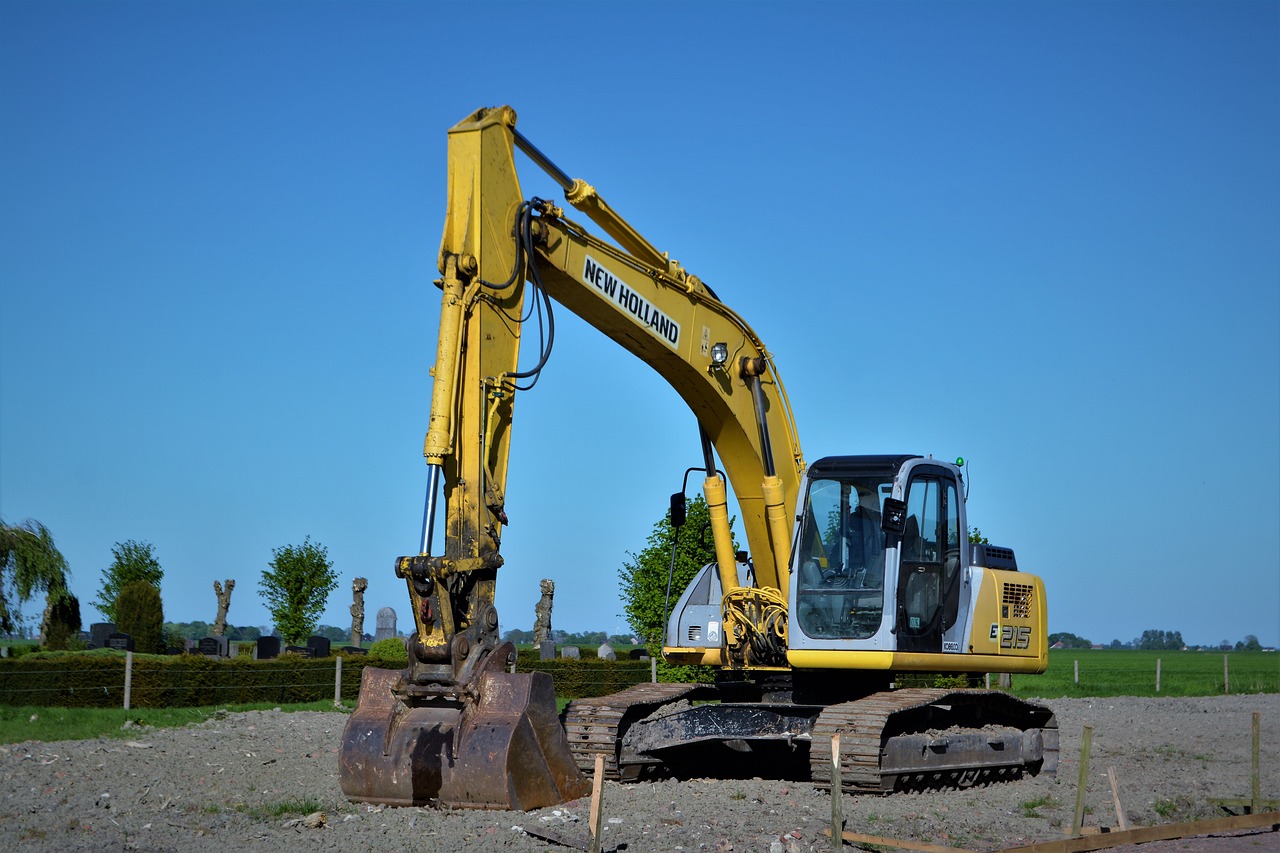The Future of Autonomous Technologies in Transportation
The world is on the brink of a revolutionary transformation in transportation, driven by the rapid advancements in autonomous technologies. Imagine a future where vehicles navigate the streets without human intervention, making decisions in real-time, and communicating with one another to ensure safety and efficiency. This is not science fiction; it’s the direction in which we are heading. As we delve into this exciting realm, we will explore the current state of autonomous vehicles, the myriad benefits they offer, the challenges that lie ahead, and the pivotal role of artificial intelligence in shaping the future of transportation.
Today, autonomous vehicles (AVs) are not just a concept but a reality, with several companies pioneering this technology. Major players like Waymo, Tesla, and Uber are at the forefront, pushing the boundaries of what’s possible. These vehicles are equipped with an array of advanced technologies such as LIDAR, radar, and cameras, allowing them to perceive their surroundings with remarkable precision. The capabilities of these vehicles range from basic lane-keeping to fully automated driving in designated areas. However, while the technology is progressing, it’s crucial to recognize the various levels of automation defined by the SAE (Society of Automotive Engineers), which categorizes vehicles from Level 0 (no automation) to Level 5 (full automation).
The potential advantages of autonomous transportation are immense, promising to reshape urban mobility in profound ways. One of the most significant benefits is improved safety. Statistics indicate that over 90% of road accidents are caused by human error. By removing the human factor, autonomous vehicles could drastically reduce the number of accidents on our roads. Additionally, AVs can contribute to reduced traffic congestion. With their ability to communicate with one another, these vehicles can optimize traffic flow, reducing the time spent in traffic jams. Furthermore, the environmental impact is noteworthy; autonomous vehicles can be programmed to drive more efficiently, leading to lower emissions and better fuel consumption.
When discussing the safety of autonomous vehicles, it’s essential to highlight the sophisticated systems designed to minimize accidents. These vehicles are equipped with advanced sensors and AI-driven decision-making processes that enhance road safety. For instance, collision avoidance systems utilize real-time data to detect obstacles and make instantaneous decisions to prevent accidents. Imagine a vehicle that can foresee a potential collision and react faster than a human driver can blink! This capability can significantly reduce the likelihood of accidents.
Collision avoidance systems are a cornerstone of autonomous vehicle technology. These systems use a combination of radar, cameras, and ultrasonic sensors to create a 360-degree view of the vehicle's environment. When a potential hazard is detected, the system can either alert the driver or take control of the vehicle to avoid a collision. This technology is akin to having a second pair of eyes on the road, constantly vigilant and ready to act.
Moreover, the data collected from autonomous vehicles can inform better road safety measures and infrastructure improvements. By analyzing patterns in driving behavior and accident occurrences, city planners can make informed decisions about where to place traffic signals, speed bumps, and pedestrian crossings. This data-driven approach can lead to safer roads for everyone.
As we face the growing threat of climate change, the environmental benefits of autonomous transportation cannot be overlooked. AVs can contribute to sustainability goals through reduced emissions and more efficient energy use. For instance, autonomous vehicles can be programmed to optimize their routes, minimizing fuel consumption and reducing the carbon footprint. Furthermore, as these vehicles are increasingly powered by electric energy, the shift towards autonomous transportation could significantly decrease our reliance on fossil fuels, paving the way for a cleaner, greener future.
Despite the promising future of autonomous technologies, there are several challenges that need to be addressed. Regulatory hurdles pose a significant barrier, as lawmakers struggle to create comprehensive regulations that can keep pace with rapid technological advancements. Moreover, public perception plays a crucial role in the acceptance of autonomous vehicles. Many individuals harbor skepticism about the safety and reliability of these technologies. Building trust among consumers is essential for the successful implementation of autonomous transportation systems.
To facilitate the widespread adoption of autonomous vehicles, a robust regulatory framework is necessary. This framework should encompass safety standards, liability issues, and data privacy concerns. Policymakers must collaborate with industry leaders to develop regulations that ensure public safety while fostering innovation.
Public acceptance is another critical factor. Many people are still hesitant to embrace the idea of relinquishing control to a machine. Education and awareness campaigns can help demystify autonomous technologies, highlighting their benefits and addressing common misconceptions. Trust is built over time, and as people witness the successful deployment of AVs, their acceptance is likely to grow.
At the heart of autonomous transportation lies artificial intelligence (AI), which enhances the functionality and efficiency of these systems. AI algorithms enable vehicles to analyze vast amounts of data from their surroundings, making real-time decisions that improve navigation and safety. For instance, AI can process data from traffic signals, road conditions, and other vehicles to optimize routes and reduce travel time.
Machine learning is a subset of AI that plays a vital role in improving vehicle performance. By continuously learning from their environment, autonomous vehicles can adapt to various driving conditions. This adaptability is crucial for ensuring safe and efficient navigation in diverse scenarios, from busy urban streets to winding rural roads.
Predictive analytics is another powerful tool in the autonomous vehicle arsenal. By analyzing historical data, AVs can anticipate traffic patterns and optimize routing. This capability not only improves the travel experience but also contributes to reducing congestion on our roads.
The future of autonomous transportation is rife with exciting trends. One notable development is the integration of AVs with smart city designs. As urban areas become increasingly interconnected, autonomous vehicles can enhance mobility and connectivity, creating a seamless transportation experience for residents. Furthermore, the rise of collaborative transportation models, such as shared autonomous vehicle services, could disrupt traditional transportation paradigms, offering more efficient and affordable options for commuters.
Smart cities leverage technology to improve the quality of life for their residents. By integrating autonomous vehicles into these designs, cities can enhance urban mobility, reduce congestion, and improve air quality. Imagine a city where your autonomous vehicle communicates with traffic lights to ensure you hit every green light, reducing your travel time and emissions!
Collaborative transportation models, including ride-sharing and carpooling, are set to gain traction as autonomous vehicle technology matures. These models can reduce the number of vehicles on the road, further alleviating traffic congestion and minimizing environmental impact. The future may see fleets of autonomous vehicles operating in unison to provide efficient, on-demand transportation services.
- What are autonomous vehicles? Autonomous vehicles are self-driving cars equipped with technology that allows them to navigate and operate without human intervention.
- How do autonomous vehicles enhance safety? They use advanced sensors and AI to detect obstacles and make real-time decisions to prevent accidents.
- What are the environmental benefits of autonomous transportation? Autonomous vehicles can reduce emissions and optimize fuel consumption, contributing to sustainability goals.
- What challenges do autonomous vehicles face? Key challenges include regulatory hurdles, public acceptance, and technological limitations.
- How is AI used in autonomous transportation? AI enhances navigation and decision-making, allowing vehicles to adapt to various driving conditions and optimize routes.

Current State of Autonomous Vehicles
The world of autonomous vehicles is rapidly evolving, and it's nothing short of fascinating! With advancements in technology, we are witnessing a transformation in how we think about transportation. Currently, autonomous vehicles (AVs) are equipped with a variety of sophisticated technologies that enable them to navigate roads with minimal human intervention. Companies like Waymo, Tesla, and Uber are leading the charge, pushing the boundaries of what we thought was possible just a few years ago.
At the heart of these innovations are advanced sensors and AI systems that allow vehicles to perceive their surroundings accurately. For instance, most AVs utilize a combination of LiDAR, radar, and cameras to create a detailed map of their environment. This data is processed in real-time, enabling the vehicle to make decisions almost instantaneously. Imagine driving through a busy city street, and the car can detect pedestrians, cyclists, and other vehicles, all while predicting their movements! It's like having a superhuman ability to foresee the future on the road.
Moreover, the safety features in these vehicles are designed to minimize risks. Many autonomous vehicles come equipped with technologies such as:
- Adaptive Cruise Control: Maintains a safe distance from the car in front.
- Lane Keeping Assistance: Helps the vehicle stay within its lane.
- Automatic Emergency Braking: Engages brakes to prevent collisions.
This impressive array of features not only enhances the driving experience but also significantly reduces the likelihood of accidents. However, despite these advancements, the journey to fully autonomous vehicles is still a work in progress. Various levels of automation are defined by the Society of Automotive Engineers (SAE), ranging from Level 0 (no automation) to Level 5 (full automation). Currently, most commercially available vehicles operate at Level 2 or Level 3, where the driver must remain engaged and ready to take control at any moment.
As we look toward the future, the integration of artificial intelligence is playing a pivotal role in the development of these technologies. AI algorithms are constantly learning from vast amounts of data, improving the vehicle's ability to handle complex driving environments. This means that every time an autonomous vehicle is on the road, it is gathering information that can enhance its performance and safety. It's almost like having a personal driving coach that gets better with every trip!
In conclusion, the current state of autonomous vehicles is a blend of cutting-edge technology and innovative thinking. While there are still challenges to overcome, the progress made so far is promising. With key players in the industry continuously pushing the envelope, we can expect to see even more remarkable developments in the coming years. The future of transportation is not just about getting from point A to point B; it's about how we can make that journey safer, smarter, and more efficient.

Benefits of Autonomous Transportation
The advent of autonomous transportation is not just a technological marvel; it has the potential to transform our daily lives in ways we never thought possible. Imagine a world where traffic jams are a thing of the past, where your vehicle knows the best route to take even before you step inside. This is not science fiction; it’s the reality that autonomous technologies are paving the way for. The benefits of these innovations extend beyond mere convenience; they touch on critical aspects of safety, efficiency, and environmental sustainability.
One of the most significant advantages of autonomous vehicles is their ability to enhance road safety. According to studies, human error accounts for approximately 94% of all traffic accidents. Autonomous vehicles, equipped with advanced sensors and artificial intelligence, are designed to minimize these errors. They can react faster than a human driver, making split-second decisions that can prevent collisions. This capability is bolstered by sophisticated collision avoidance systems, which continuously scan the environment for potential hazards. By leveraging these technologies, we can expect a substantial reduction in accidents and fatalities on our roads.
In addition to safety, autonomous transportation holds the promise of reducing traffic congestion. Picture this: cars communicating with one another to optimize traffic flow, adjusting their speeds and routes in real-time. This level of coordination can significantly decrease the number of vehicles on the road at any given time, leading to smoother commutes and less frustration. Moreover, with the integration of smart traffic management systems, autonomous vehicles can help manage urban traffic more effectively, leading to shorter travel times and improved overall efficiency.
Another compelling benefit of autonomous transportation is its potential to contribute to environmental sustainability. As cities grapple with pollution and climate change, the need for greener alternatives has never been more pressing. Autonomous vehicles can be designed to operate on electric power, significantly reducing greenhouse gas emissions compared to traditional vehicles. Furthermore, by optimizing driving patterns and reducing unnecessary idling, these vehicles can improve fuel efficiency, leading to lower energy consumption. This not only benefits the environment but also helps to create cleaner, healthier urban spaces.
To summarize, the benefits of autonomous transportation can be categorized into three main areas:
- Enhanced Safety: Reduction in accidents due to advanced sensors and AI technology.
- Traffic Efficiency: Improved traffic flow and reduced congestion through vehicle communication.
- Environmental Sustainability: Lower emissions and energy consumption through optimized driving and electric vehicles.
As we move forward, it’s essential to recognize that the journey toward widespread adoption of autonomous transportation is not just about technology; it’s about changing our mindset. Embracing these innovations could lead to a future where our cities are not only smarter but also safer and more sustainable. The road ahead is filled with opportunities, and it’s up to us to navigate this exciting terrain.
Q1: What are autonomous vehicles?
A1: Autonomous vehicles are cars or trucks that are capable of navigating and driving themselves without human intervention, using a combination of sensors, cameras, and artificial intelligence.
Q2: How do autonomous vehicles improve safety?
A2: They reduce human error, which is a major cause of accidents, by utilizing advanced technologies such as collision avoidance systems and real-time decision-making algorithms.
Q3: What impact will autonomous vehicles have on traffic congestion?
A3: Autonomous vehicles can communicate with each other and traffic systems to optimize driving patterns, which can lead to reduced congestion and improved traffic flow.
Q4: Are autonomous vehicles environmentally friendly?
A4: Yes, many autonomous vehicles are designed to run on electric power, which can significantly lower emissions and promote energy efficiency in urban areas.

Safety Enhancements
When we think about the future of transportation, one of the most exciting aspects is the enhanced safety features that autonomous vehicles bring to the table. Imagine a world where the fear of accidents is significantly reduced, where every drive feels like a safe journey, and where technology works tirelessly to protect us on the roads. Autonomous vehicles are equipped with a range of advanced technologies designed to minimize accidents and enhance road safety. These vehicles utilize sophisticated sensors, cameras, and artificial intelligence to make split-second decisions that can mean the difference between a safe trip and a collision.
One of the key components of these safety systems is the collision avoidance technology. This involves a combination of radar, lidar, and computer vision systems that allow the vehicle to detect obstacles and potential hazards in real-time. For instance, if a pedestrian suddenly crosses the road, the vehicle can instantly analyze the situation and take necessary actions, such as braking or steering away. The beauty of this technology lies in its ability to process vast amounts of data in milliseconds, something that human drivers simply cannot match.
Moreover, autonomous vehicles are not just reacting to immediate dangers; they are also learning from their experiences. This is where data-driven safety improvements come into play. Each time an autonomous vehicle is on the road, it collects valuable data that can be analyzed to improve future performance. For example, if a vehicle encounters a tricky intersection, the data gathered can inform better road safety measures and infrastructure improvements. This continuous feedback loop not only enhances the vehicle's operational safety but also contributes to broader public safety initiatives.
To illustrate the effectiveness of these systems, let's consider a hypothetical scenario. Imagine a busy urban intersection where traditional vehicles often struggle to navigate due to unpredictable pedestrian movements and cyclists weaving through traffic. An autonomous vehicle equipped with advanced collision avoidance systems can monitor all these variables simultaneously. It can anticipate potential conflicts and adjust its speed and trajectory accordingly, effectively reducing the risk of accidents.
In summary, the safety enhancements offered by autonomous vehicles represent a monumental shift in how we approach road safety. With their ability to detect and react to dangers faster than humans, coupled with the power of data analytics to inform ongoing improvements, these technologies are paving the way for safer streets. As we look to the future, the integration of these advanced safety features will be crucial in gaining public trust and acceptance of autonomous transportation.
- How do autonomous vehicles avoid accidents? Autonomous vehicles use a combination of sensors, cameras, and AI algorithms to detect obstacles and make real-time decisions to avoid collisions.
- Can autonomous vehicles learn from their experiences? Yes, they collect data during each trip, which can be analyzed to improve safety measures and vehicle performance over time.
- What role does AI play in vehicle safety? AI enhances the decision-making capabilities of autonomous vehicles, allowing them to process information quickly and accurately to ensure safer driving.

Collision Avoidance Systems
Collision avoidance systems are at the forefront of making autonomous vehicles safer and more reliable. Imagine driving down a busy street, and suddenly, a child runs into the road. In a split second, the vehicle must assess the situation, make a decision, and take action to prevent an accident. This is where collision avoidance systems shine. They utilize a combination of advanced sensors, cameras, and artificial intelligence to detect potential hazards and react accordingly.
These systems are designed to function in real-time, analyzing data from various sources to create a comprehensive understanding of the vehicle's surroundings. For instance, radar and lidar technologies are employed to identify obstacles, while cameras help in recognizing road signs and lane markings. This multi-faceted approach ensures that the vehicle can accurately gauge distances and speeds, allowing it to make informed decisions. The integration of these technologies not only enhances safety but also instills a sense of confidence for passengers and pedestrians alike.
One of the key components of collision avoidance systems is the ability to predict potential accidents before they occur. By continuously monitoring the environment, these systems can alert the driver or autonomously apply brakes to avoid a collision. This proactive measure is crucial in reducing the number of accidents on the road. According to statistics, vehicles equipped with such systems have shown a significant reduction in collision rates, demonstrating their effectiveness.
Moreover, the data collected by these systems can be invaluable for improving road safety on a broader scale. As autonomous vehicles navigate through various environments, they gather extensive data on traffic patterns, road conditions, and accident hotspots. This information can then be analyzed to inform urban planning and enhance infrastructure, ultimately leading to safer roads for all users. For example, city planners can utilize this data to identify areas that require better signage, improved lighting, or additional traffic signals.
In summary, collision avoidance systems represent a significant leap forward in automotive safety technology. By harnessing the power of advanced sensors and AI, these systems not only protect occupants but also contribute to a broader vision of safer urban mobility. As we continue to embrace the future of autonomous vehicles, the importance of these systems will only grow, paving the way for a new era of transportation.
- What are collision avoidance systems? Collision avoidance systems are technologies integrated into vehicles that help detect potential hazards and take action to prevent accidents.
- How do these systems work? They use various sensors, cameras, and AI algorithms to analyze the vehicle's surroundings in real-time, allowing for quick decision-making.
- Are collision avoidance systems effective? Yes, studies have shown that vehicles equipped with these systems experience significantly fewer collisions compared to those without them.
- Can these systems replace human drivers? While they greatly enhance safety, collision avoidance systems are designed to assist human drivers rather than replace them entirely, especially in complex driving environments.

Data-Driven Safety Improvements
In the realm of autonomous vehicles, the integration of data analytics is revolutionizing how we approach road safety. Imagine a world where every vehicle on the road is not just a mode of transport but a data-gathering machine, continuously learning from its environment. This is the essence of data-driven safety improvements. Autonomous vehicles are equipped with an array of sensors and cameras that collect vast amounts of data every second. This data, when analyzed, allows manufacturers and developers to identify patterns, predict potential hazards, and improve vehicle performance.
For instance, consider how autonomous vehicles can learn from near-miss incidents. By analyzing data from multiple vehicles, developers can pinpoint common factors that lead to these close calls. This information is invaluable; it allows for the refinement of algorithms that govern vehicle behavior, ultimately leading to safer driving practices. Moreover, this data can inform infrastructure improvements. If a particular intersection shows a high frequency of near-misses, city planners can investigate and implement changes, such as adjusting traffic signals or adding signage.
Furthermore, the feedback loop created by data analytics is crucial in enhancing the overall safety of autonomous transportation systems. Each time a vehicle encounters a new situation, it records the data, which can then be aggregated with data from thousands of other vehicles. This collective intelligence enables manufacturers to continuously update their safety protocols and software. As a result, the vehicles are not only improving their own safety features but also contributing to a safer driving environment for all road users.
To illustrate the impact of data-driven safety improvements, let's take a look at some key statistics:
| Year | Incidents Reduced (%) | Data Points Collected (millions) |
|---|---|---|
| 2020 | 15% | 500 |
| 2021 | 25% | 1,200 |
| 2022 | 35% | 2,500 |
This table shows a clear trend: as the amount of data collected increases, the number of incidents reported decreases significantly. It’s a powerful testament to the capabilities of data-driven approaches in enhancing safety.
In conclusion, data-driven safety improvements are not just a theoretical concept; they are a practical reality that is reshaping our understanding of road safety. By leveraging the power of data, we can create a safer future for all road users, where autonomous vehicles not only navigate our roads but also contribute to a culture of safety and awareness.
- How do autonomous vehicles collect data? Autonomous vehicles use a combination of sensors, cameras, and radar systems to gather data about their surroundings, including other vehicles, pedestrians, and road conditions.
- What happens to the data collected by autonomous vehicles? The data is analyzed to improve vehicle algorithms, enhance safety features, and inform infrastructure changes to reduce accidents.
- Are data-driven safety improvements effective? Yes, studies have shown that as the volume of data collected increases, the number of incidents involving autonomous vehicles tends to decrease.

Environmental Impact
The rise of autonomous transportation systems is not just a technological revolution; it also holds the potential to significantly reshape our environmental landscape. With the world grappling with climate change and urban pollution, the integration of autonomous vehicles (AVs) into our transportation networks could be a game-changer. Imagine a future where vehicles communicate with each other, optimizing routes and reducing idle times. This could lead to a dramatic decrease in greenhouse gas emissions, making our cities cleaner and healthier for everyone.
One of the most compelling benefits of autonomous vehicles is their ability to enhance energy efficiency. Traditional vehicles often operate at sub-optimal levels, leading to wasted fuel and increased emissions. In contrast, autonomous vehicles are equipped with advanced algorithms that allow them to drive more efficiently. For example, they can maintain consistent speeds, reduce sudden accelerations and decelerations, and utilize regenerative braking systems. This not only conserves energy but also extends the life of the vehicle's components.
Moreover, the environmental impact of autonomous transportation extends beyond just emissions. These vehicles can contribute to a more sustainable urban infrastructure in various ways:
- Reduced Traffic Congestion: By optimizing traffic flow and minimizing stop-and-go driving, autonomous vehicles can help alleviate congestion, which is a major contributor to urban pollution.
- Encouragement of Shared Mobility: Autonomous vehicles can promote car-sharing and ride-hailing services, leading to fewer cars on the road. This not only reduces emissions but also lessens the demand for parking spaces, freeing up valuable urban land for green spaces.
- Integration with Renewable Energy: Many autonomous vehicle systems are being designed to work in conjunction with renewable energy sources, such as solar or wind power, further decreasing their carbon footprint.
To put this into perspective, a study conducted by the International Council on Clean Transportation found that widespread adoption of autonomous vehicles could potentially reduce emissions by up to 80% compared to current levels. This is a staggering figure that highlights the transformative potential of this technology.
However, it's important to note that the environmental benefits of autonomous vehicles will largely depend on how they are integrated into existing transportation ecosystems. For instance, if AVs are primarily used as single-occupancy vehicles, they may inadvertently lead to increased travel distances and energy consumption. Therefore, strategic planning and policy-making will be essential to ensure that these technologies align with sustainability goals.
In conclusion, the environmental impact of autonomous transportation is a multifaceted issue that presents both opportunities and challenges. As we move forward, it will be crucial to harness the potential of these technologies to create a sustainable future, where urban mobility is not just efficient but also environmentally friendly. The road ahead is exciting, and with the right approach, we can pave the way for a cleaner, greener planet.
- What are the main environmental benefits of autonomous vehicles? Autonomous vehicles can reduce emissions, improve energy efficiency, and encourage shared mobility, leading to less traffic congestion and pollution.
- How do autonomous vehicles achieve better fuel efficiency? They utilize advanced algorithms to optimize driving patterns, maintain consistent speeds, and reduce unnecessary stops, which helps in conserving fuel.
- Can autonomous vehicles help in combating climate change? Yes, by significantly reducing greenhouse gas emissions and integrating with renewable energy sources, AVs can contribute to climate change mitigation efforts.
- What role does urban planning play in the environmental impact of autonomous vehicles? Effective urban planning is essential to ensure that AVs are integrated in a way that maximizes their environmental benefits, such as promoting shared mobility and reducing single-occupancy trips.

Challenges Facing Autonomous Technologies
The journey toward a future dominated by autonomous vehicles is not without its hurdles. As we stand on the brink of a transportation revolution, several challenges threaten to slow down the widespread adoption of these innovative technologies. From regulatory frameworks to public acceptance, the road ahead is filled with twists and turns that must be navigated carefully.
One of the most significant challenges is the regulatory landscape. Governments around the world are grappling with how to create comprehensive laws that can keep pace with the rapid advancements in autonomous technology. The absence of clear regulations leads to uncertainty for manufacturers and consumers alike. For instance, if a self-driving car were to be involved in an accident, who would be held liable? The manufacturer, the software developer, or the vehicle owner? These questions remain unanswered, creating a significant barrier to entry for many companies looking to innovate in this space.
Moreover, public acceptance plays a crucial role in the success of autonomous transportation. Many people still harbor doubts about the safety and reliability of self-driving vehicles. This skepticism is often fueled by sensationalized media coverage of accidents involving autonomous cars, overshadowing the extensive safety measures and testing protocols that these vehicles undergo. To bridge this gap, stakeholders must engage in transparent communication, showcasing the benefits and safety features of autonomous technologies to build trust among consumers.
Technological limitations also pose a challenge. While autonomous vehicles are equipped with advanced sensors and artificial intelligence, they still struggle in complex driving environments. For example, navigating through heavy rain, snow, or construction zones can be problematic. These conditions can hinder the vehicle's ability to accurately perceive its surroundings, leading to potential safety risks. Continuous advancements in machine learning and sensor technology are essential to overcome these limitations and enhance the reliability of autonomous systems.
To summarize, the key challenges facing autonomous technologies include:
- Regulatory Frameworks: Need for comprehensive laws and regulations.
- Public Acceptance: Overcoming skepticism and building consumer trust.
- Technological Limitations: Addressing issues in complex driving environments.
While these challenges may seem daunting, they also present opportunities for innovation and collaboration among various stakeholders. By working together—governments, manufacturers, and the public—we can pave the way for a safer, more efficient, and more sustainable transportation future. The key lies in fostering a dialogue that prioritizes safety and transparency, ensuring that everyone is on board as we drive into this exciting new era.
- What are the main challenges facing autonomous vehicles?
The main challenges include regulatory frameworks, public acceptance, and technological limitations. - How can governments support the development of autonomous technologies?
Governments can create clear regulations, invest in infrastructure, and promote public awareness campaigns. - What role does public perception play in the adoption of autonomous vehicles?
Public perception significantly impacts the acceptance and trust in autonomous vehicles, influencing their widespread adoption.

Regulatory Frameworks
The development of autonomous vehicles (AVs) has sparked a whirlwind of excitement and innovation, but it has also raised a multitude of questions regarding regulation. As these technologies evolve at a breakneck pace, the regulatory frameworks that govern them must adapt accordingly. Imagine trying to catch a train that’s already left the station; that’s how it feels trying to keep regulations aligned with the rapid advancements in AV technology.
Currently, the regulatory landscape is a patchwork of state, national, and international laws, which can create confusion and inconsistency. Different regions have different rules, leading to a scenario where companies must navigate a complex maze just to test their vehicles. For instance, while some states in the U.S. have established clear guidelines for testing AVs, others remain ambiguous, leaving manufacturers in a state of uncertainty. This inconsistency can stifle innovation and hinder the widespread adoption of AVs.
To address these challenges, there is a pressing need for comprehensive and cohesive regulations that not only ensure public safety but also foster innovation. Regulatory bodies must work closely with technology developers to create frameworks that are flexible enough to adapt to new advancements while still providing necessary safeguards. This collaboration can take the form of public-private partnerships, where stakeholders come together to establish guidelines that benefit both the industry and consumers.
Moreover, regulations should focus on key areas such as:
- Safety Standards: Establishing clear safety benchmarks that AVs must meet before they can be deployed on public roads.
- Data Privacy: Ensuring that the data collected by AVs is protected and used ethically.
- Liability Issues: Defining who is responsible in the event of an accident involving an autonomous vehicle.
Countries around the world are taking different approaches to the regulatory frameworks for AVs. For example, Germany has implemented a law that allows for the testing of self-driving cars under certain conditions, while the United States has seen various states adopting their own rules. This disparity can lead to a competitive advantage for regions with more favorable regulations, potentially driving innovation away from areas with stricter rules.
In conclusion, developing effective regulatory frameworks is crucial for the successful integration of autonomous technologies into our transportation systems. Without clear and cohesive guidelines, the potential benefits of AVs—such as enhanced safety, reduced congestion, and improved environmental outcomes—may be delayed or lost altogether. As we look to the future, it’s essential that regulators, industry leaders, and the public work together to create an environment that supports innovation while ensuring the safety and well-being of all road users.
- What are the main challenges in creating regulatory frameworks for autonomous vehicles? The main challenges include the rapid pace of technological advancements, inconsistency in existing laws across regions, and the need for collaboration between regulators and industry stakeholders.
- How can public-private partnerships help in developing regulations? Public-private partnerships can foster collaboration, allowing regulators to gain insights from technology developers, which helps in creating flexible and effective guidelines.
- What areas should regulations focus on for autonomous vehicles? Regulations should focus on safety standards, data privacy, and liability issues to ensure a comprehensive approach to AV integration.

Public Acceptance
When it comes to the future of autonomous vehicles, one of the most significant hurdles we face is . Imagine standing at a busy intersection, watching a car drive itself flawlessly while you wonder, "Would I trust that vehicle to take me home?" This skepticism is normal, especially when considering the implications of relinquishing control to a machine. The truth is, while the technology behind autonomous vehicles is advancing rapidly, the human element—our emotions, fears, and perceptions—plays a crucial role in determining how quickly these innovations will be embraced.
To foster public acceptance, it's essential to address several key factors that influence consumer attitudes:
- Trust in Technology: People need to believe that these vehicles are safe and reliable. Trust is built through transparency about how autonomous systems work and their safety records.
- Education and Awareness: Many individuals may not fully understand the capabilities of autonomous vehicles. Educational campaigns can demystify the technology, showcasing its benefits and addressing misconceptions.
- Personal Experiences: As more people encounter autonomous vehicles, whether through ride-sharing services or public transport, their firsthand experiences can significantly shape their perceptions.
Moreover, public acceptance is not a one-size-fits-all scenario. Different demographics may have varying levels of comfort with the technology. For example, younger generations, who are generally more tech-savvy, may be more inclined to embrace autonomous vehicles compared to older adults who might prefer traditional driving methods. Understanding these nuances is vital for manufacturers and policymakers alike as they strive to create a transportation system that is not only efficient but also widely accepted.
In addition, companies developing autonomous technologies must engage with communities and stakeholders to build trust and address concerns. This could involve public demonstrations, open forums for discussion, and collaborations with local governments to ensure that the implementation of autonomous vehicles aligns with community values and needs. By actively involving the public in the conversation, we can help pave the way for a smoother transition into a future where autonomous transportation is a norm rather than an exception.
Ultimately, the journey towards widespread acceptance of autonomous vehicles is a multifaceted challenge. It requires not only technological advancements but also a concerted effort to understand and address the public's fears and expectations. As we move forward, it’s crucial to remember that the success of autonomous transportation hinges on the trust and confidence of the people it aims to serve.
- What are the main concerns about autonomous vehicles? Many people worry about safety, data privacy, and the potential for job loss in driving professions.
- How can public trust in autonomous vehicles be built? Through transparency, education, and positive personal experiences with the technology.
- Are there any regulations governing autonomous vehicles? Yes, regulations vary by country and state, and they are continuously evolving to keep pace with advancements in technology.

The Role of AI in Transportation
Artificial Intelligence (AI) is not just a buzzword; it’s the backbone of the autonomous transportation revolution. Imagine a world where cars drive themselves, adjusting their speed, direction, and even their routes based on real-time data. Sounds futuristic, right? Well, that future is rapidly becoming our reality, thanks to AI. The integration of AI in transportation systems is transforming how we think about mobility, safety, and efficiency.
At its core, AI enhances the functionality of autonomous vehicles by enabling them to process vast amounts of data from their surroundings. This data includes everything from traffic signals and road conditions to the behavior of other drivers and pedestrians. By utilizing advanced algorithms, AI systems can make split-second decisions that enhance safety and improve traffic flow. For instance, when a vehicle encounters a sudden obstacle, AI can quickly assess the situation and determine the best course of action—whether to brake, swerve, or accelerate.
One of the most exciting applications of AI in transportation is through machine learning. This subset of AI allows vehicles to learn from their experiences, continuously improving their performance. For example, as an autonomous vehicle navigates through various environments—urban streets, highways, or rural roads—it gathers data that helps refine its driving algorithms. Over time, this leads to a more reliable and efficient driving experience. Moreover, machine learning can adapt to different driving conditions, ensuring that the vehicle performs optimally regardless of the environment.
Another significant aspect of AI in transportation is the use of predictive analytics. This technology analyzes historical data to forecast future traffic patterns, enabling vehicles to optimize their routes. Imagine a busy city where autonomous vehicles can communicate with each other and the traffic management system to avoid congested areas. By predicting traffic jams or accidents, these vehicles can reroute themselves in real-time, significantly reducing travel time and enhancing overall efficiency. This not only benefits individual drivers but also contributes to a smoother flow of traffic across the entire city.
Furthermore, AI plays a crucial role in enhancing the safety features of autonomous vehicles. Advanced driver-assistance systems (ADAS) utilize AI to monitor the vehicle's surroundings, providing crucial information that helps prevent accidents. Features such as lane-keeping assistance, adaptive cruise control, and automatic emergency braking are all powered by AI technologies that analyze data from cameras, radar, and sensors. These systems work tirelessly to ensure that the vehicle operates safely, giving passengers peace of mind.
As we look to the future, the role of AI in transportation is poised to expand even further. The integration of AI with smart city initiatives is a developing trend that promises to revolutionize urban mobility. By connecting autonomous vehicles with smart infrastructure—such as traffic signals, public transport systems, and even pedestrian crossings—cities can create a more cohesive and efficient transportation ecosystem. This synergy can lead to reduced congestion, lower emissions, and improved overall quality of life for urban dwellers.
In conclusion, the role of AI in transportation is not just about creating self-driving cars; it’s about reshaping our entire transportation landscape. As AI technologies continue to evolve, they will unlock new possibilities for safer, more efficient, and environmentally friendly transportation solutions. The future is bright, and with AI at the helm, we are steering towards a new era of mobility.
- What is the main role of AI in autonomous vehicles?
AI enables autonomous vehicles to process data from their environment, make real-time decisions, and learn from their experiences to improve performance. - How does machine learning contribute to transportation?
Machine learning allows vehicles to adapt to different driving conditions and improve their algorithms based on past experiences. - What are predictive analytics, and how do they benefit transportation?
Predictive analytics uses historical data to forecast traffic patterns, helping vehicles optimize their routes and reduce congestion. - How does AI enhance safety in autonomous vehicles?
AI powers advanced safety features that monitor the vehicle's surroundings and assist in accident prevention.

Machine Learning Applications
When we think about the future of autonomous vehicles, one of the most exciting aspects is the role of machine learning. This technology is like the brain of autonomous systems, enabling them to learn from their environment and improve over time. Imagine your car not just following a set of pre-programmed rules, but actually learning from its experiences on the road, much like how we adapt our driving based on different conditions. This capability is pivotal for enhancing vehicle performance and ensuring safer journeys.
Machine learning algorithms analyze vast amounts of data collected from sensors and cameras installed in autonomous vehicles. These algorithms can identify patterns and make predictions, which significantly enhances the vehicle's ability to navigate complex environments. For instance, when a car encounters a busy intersection, it can use machine learning to assess traffic patterns, predict the behavior of other drivers, and make real-time decisions to ensure safe passage. This is akin to having a seasoned driver who can read the road and anticipate potential hazards.
Moreover, the applications of machine learning extend beyond just driving. They also play a crucial role in vehicle maintenance. By analyzing data from various components, machine learning can predict when a part is likely to fail, allowing for timely maintenance and reducing the risk of breakdowns. This predictive maintenance approach not only enhances safety but also improves the overall lifespan of the vehicle.
Another fascinating application is in the realm of adaptive learning. Autonomous vehicles can adjust their driving styles based on the preferences of the occupants. For example, if a passenger prefers a smoother ride, the vehicle can learn to optimize its acceleration and braking patterns accordingly. This personalization makes the driving experience more enjoyable and comfortable, akin to having a personal chauffeur who knows your preferences.
As we look toward the future, the integration of machine learning with other technologies like computer vision and natural language processing will further enhance the capabilities of autonomous vehicles. These advancements will enable cars to not only see and interpret their surroundings but also understand verbal commands from passengers, creating an intuitive and interactive driving experience.
In summary, machine learning is at the heart of autonomous vehicle technology, driving innovations that enhance safety, efficiency, and user experience. As these systems continue to evolve, we can expect to see even more remarkable applications that will transform how we think about transportation.
- What is machine learning in autonomous vehicles?
Machine learning refers to the algorithms that enable autonomous vehicles to learn from data, adapt to new situations, and improve their performance over time.
- How does machine learning enhance vehicle safety?
By analyzing data from sensors, machine learning can predict potential hazards and make real-time decisions to avoid accidents.
- Can autonomous vehicles learn from their passengers?
Yes, autonomous vehicles can adapt their driving styles based on the preferences of their passengers, providing a personalized experience.

Predictive Analytics
Predictive analytics is revolutionizing the way we approach transportation, particularly in the realm of autonomous vehicles. By leveraging vast amounts of data, these systems can forecast potential outcomes and optimize decision-making processes on the road. Imagine having a co-pilot who not only knows where you're headed but can also anticipate traffic jams, accidents, and even the weather conditions ahead. That's the power of predictive analytics!
At its core, predictive analytics utilizes historical data, statistical algorithms, and machine learning techniques to identify the likelihood of future events. In the context of autonomous transportation, this means that vehicles can analyze real-time data from various sources, including traffic patterns, road conditions, and even social media reports about accidents or road closures. By processing this information, autonomous vehicles can make informed decisions that enhance safety and efficiency.
For instance, if a self-driving car detects a sudden slowdown in traffic ahead, it can quickly calculate alternate routes or adjust its speed to avoid a potential collision. This level of responsiveness not only improves the driving experience but also contributes to overall traffic flow. The table below illustrates how predictive analytics can enhance various aspects of transportation:
| Aspect | Predictive Analytics Application | Benefit |
|---|---|---|
| Traffic Management | Analyzing traffic flow data to predict congestion | Reduced travel time and improved efficiency |
| Route Optimization | Real-time route adjustments based on current conditions | Enhanced safety and reduced risk of accidents |
| Maintenance Scheduling | Predicting vehicle maintenance needs | Minimized downtime and increased vehicle lifespan |
Moreover, predictive analytics also plays a crucial role in enhancing the user experience. By analyzing user preferences and behaviors, autonomous vehicles can offer personalized routes, suggest optimal departure times, and even recommend nearby amenities. This level of customization not only makes the journey more enjoyable but also encourages users to embrace autonomous technologies.
However, it's essential to recognize that predictive analytics is not without its challenges. The accuracy of predictions relies heavily on the quality of data collected. Incomplete or biased data can lead to erroneous conclusions, which could compromise safety and efficiency. Therefore, continuous data gathering and refinement of algorithms are critical to ensuring that predictive analytics remains a reliable tool in autonomous transportation.
In summary, predictive analytics is a game-changer in the world of autonomous vehicles. By harnessing the power of data, these systems can enhance decision-making, improve safety, and create a more efficient transportation ecosystem. As we move forward, the integration of predictive analytics will undoubtedly play a pivotal role in shaping the future of how we travel.
- What is predictive analytics?
Predictive analytics involves using historical data and statistical algorithms to forecast future events and optimize decision-making processes.
- How does predictive analytics improve autonomous vehicles?
It enhances decision-making by analyzing real-time data to anticipate traffic conditions, optimize routes, and improve safety.
- What are the main challenges of predictive analytics in transportation?
The accuracy of predictions can be affected by the quality of data collected, which can lead to potential safety issues if not properly managed.

Future Trends in Autonomous Transportation
The future of autonomous transportation is not just a distant dream; it’s unfolding right before our eyes. As technology continues to advance at a breakneck pace, we’re witnessing exciting trends that promise to revolutionize how we navigate our cities and beyond. One of the most significant trends is the integration of autonomous vehicles with smart city infrastructure. Imagine a world where your self-driving car communicates seamlessly with traffic lights, public transit systems, and even other vehicles on the road. This integration will not only enhance mobility but also optimize traffic flow, reducing congestion and improving overall urban efficiency.
Moreover, the rise of collaborative transportation models is set to change the traditional paradigms of personal vehicle ownership. With the increasing popularity of ride-sharing services, we can expect to see more shared autonomous vehicle services emerging. These services will allow users to summon a vehicle on-demand, providing a flexible and economical alternative to owning a car. This shift could significantly reduce the number of vehicles on the road, leading to decreased emissions and less strain on urban infrastructure.
Another exciting trend is the development of advanced AI systems that enhance the capabilities of autonomous vehicles. These systems will leverage machine learning and predictive analytics to improve navigation and decision-making in real-time. For instance, AI can analyze traffic patterns and predict congestion, allowing vehicles to choose the most efficient routes. This not only saves time for passengers but also contributes to lower fuel consumption and reduced environmental impact.
As we look forward, the concept of mobility as a service (MaaS) is gaining traction. This model envisions a seamless integration of various transportation options—bikes, buses, trains, and autonomous vehicles—into a single service accessible through a mobile app. Users could plan, book, and pay for their entire journey using one platform, making transportation more convenient and efficient. The implications for urban planning are profound, as cities will need to adapt their infrastructure to accommodate this new way of moving.
To better illustrate these trends, let's take a look at the following table highlighting key developments in autonomous transportation:
| Trend | Description | Potential Impact |
|---|---|---|
| Integration with Smart Cities | Seamless communication between vehicles and city infrastructure. | Reduced congestion, improved traffic flow. |
| Collaborative Transportation Models | Shared autonomous vehicle services replacing personal ownership. | Lower emissions, reduced vehicle numbers. |
| Advanced AI Systems | Real-time navigation and decision-making enhancements. | Increased efficiency, reduced travel times. |
| Mobility as a Service (MaaS) | Integration of multiple transport modes into a single service. | Convenient travel, streamlined urban mobility. |
In conclusion, the future of autonomous transportation is bright and filled with possibilities. As these trends continue to evolve, they will not only transform how we travel but also how we design our cities and interact with our environment. The key will be to embrace these changes, ensuring that they lead to a safer, more efficient, and sustainable future for everyone.
Q: What are autonomous vehicles?
A: Autonomous vehicles are self-driving cars that use a combination of sensors, cameras, and artificial intelligence to navigate without human intervention.
Q: How will autonomous vehicles impact traffic congestion?
A: By optimizing routes and reducing the number of vehicles on the road through shared services, autonomous vehicles can significantly decrease traffic congestion.
Q: Are autonomous vehicles safe?
A: Yes, autonomous vehicles are designed with advanced safety features that minimize accidents and enhance road safety through real-time data processing and decision-making.
Q: What role does AI play in autonomous transportation?
A: AI enhances navigation, decision-making, and predictive analytics, allowing autonomous vehicles to adapt to changing traffic conditions and improve overall efficiency.
Q: What is Mobility as a Service (MaaS)?
A: MaaS is a model that integrates various transportation options into a single service, allowing users to plan, book, and pay for their journeys through one platform.

Integration with Smart Cities
The concept of smart cities is rapidly gaining traction as urban areas strive to enhance the quality of life for their residents through technology. Autonomous vehicles (AVs) are poised to play a critical role in this transformation. Imagine a city where traffic flows seamlessly, public transportation is efficient, and emissions are drastically reduced. This isn't just a dream; it's the future that smart cities and autonomous technologies are working towards together.
At the heart of this integration is the idea of connectivity. Autonomous vehicles will not operate in isolation; they will communicate with other vehicles, traffic signals, and even the city’s infrastructure. This interconnectivity allows for real-time data exchange, which can significantly improve traffic management and reduce congestion. For instance, when an AV approaches an intersection, it can receive information about the traffic light status and adjust its speed accordingly, ensuring a smoother flow of traffic.
Furthermore, the integration of autonomous vehicles into smart city frameworks can lead to more efficient public transportation systems. By utilizing data-driven insights, cities can optimize bus routes and schedules, making public transport more appealing and reducing the reliance on personal vehicles. Imagine a scenario where an autonomous shuttle picks you up at your doorstep and drops you off at the nearest transit hub, all while dynamically adjusting its route based on current demand and traffic conditions. This level of convenience can significantly enhance urban mobility.
However, the successful integration of AVs into smart cities is not without challenges. Urban planners must consider various factors, including infrastructure upgrades, data privacy concerns, and the potential for increased urban sprawl. Moreover, public acceptance plays a crucial role. People need to feel comfortable with the idea of sharing their roads with autonomous vehicles, which requires extensive education and outreach efforts.
To illustrate the potential benefits of integrating autonomous vehicles into smart cities, consider the following table:
| Benefits | Description |
|---|---|
| Reduced Traffic Congestion | Autonomous vehicles can communicate with each other and traffic systems, optimizing routes and reducing delays. |
| Enhanced Safety | With advanced sensors and AI, AVs can significantly decrease the likelihood of accidents. |
| Lower Emissions | AVs can be designed to operate on electric power, contributing to cleaner air in urban areas. |
| Improved Accessibility | Autonomous transport solutions can provide mobility options for those unable to drive, including the elderly and disabled. |
In conclusion, the integration of autonomous vehicles into smart cities presents a unique opportunity to revolutionize urban living. By enhancing connectivity, improving public transport, and addressing urban challenges, AVs can help create a more efficient, safer, and sustainable urban environment. As we move forward, it is essential for city planners, technology developers, and the public to work together to ensure that this vision becomes a reality.
- What are smart cities? Smart cities use technology and data to improve urban living, focusing on sustainability, efficiency, and quality of life.
- How do autonomous vehicles contribute to smart cities? AVs enhance connectivity, reduce traffic congestion, and improve public transportation efficiency.
- What challenges exist with integrating AVs into urban environments? Key challenges include infrastructure needs, public acceptance, and data privacy concerns.
- Will autonomous vehicles reduce traffic accidents? Yes, AVs are designed with advanced safety features that can significantly minimize the risk of accidents.

Collaborative Transportation Models
The concept of is revolutionizing the way we think about mobility in urban environments. Imagine a world where your car isn't just a solitary vessel, but part of a larger, interconnected network of vehicles working together to streamline travel. This isn't just a futuristic dream; it's becoming a reality as autonomous vehicles (AVs) begin to integrate with existing transportation systems.
At the heart of this transformation is the idea of shared mobility. Rather than each person owning a vehicle, we can leverage technology to create services that allow multiple users to access autonomous cars on-demand. This can significantly reduce the number of vehicles on the road, leading to less congestion and lower emissions. Think of it like sharing a ride with friends, but on a much larger scale, where your ride is automatically coordinated with others heading in the same direction.
One of the most exciting aspects of collaborative transportation is the potential for dynamic routing. Using real-time data, autonomous vehicles can adjust their routes based on current traffic conditions, weather, and even the preferences of the passengers. For instance, if a group of people needs to get to a concert, an AV could optimize the route to pick them up in the most efficient manner, minimizing wait times and maximizing convenience. This level of adaptability is something traditional transportation models struggle to achieve.
Moreover, collaborative models can lead to the development of multi-modal transportation systems. These systems integrate various forms of transportation—like buses, trains, bikes, and AVs—into a seamless experience. Imagine planning your trip on a single app that suggests the best combination of transport options, including an autonomous shuttle to the train station, followed by a bike ride to your final destination. This holistic approach not only enhances user experience but also promotes the use of sustainable transport options, reducing our carbon footprint.
However, the success of collaborative transportation models hinges on a few critical factors:
- Infrastructure Development: Cities will need to invest in smart infrastructure that supports vehicle-to-everything (V2X) communication, allowing AVs to interact with traffic signals, road signs, and even other vehicles.
- Data Sharing: For these systems to operate efficiently, data sharing between different transportation services is essential. This means creating standards for data interoperability that can facilitate smooth communication across platforms.
- Regulatory Frameworks: Governments will play a crucial role in establishing regulations that ensure safety and encourage innovation in collaborative transportation models.
As we look to the future, it's evident that collaborative transportation models will not only change how we commute but also reshape urban landscapes. With the rise of autonomous vehicles, we are on the brink of a new era where transportation is not just about getting from point A to point B, but about enhancing the overall quality of urban life. The potential is enormous, and as cities adapt to these changes, we can expect to see a more connected, efficient, and sustainable future.
Q: What are collaborative transportation models?
A: Collaborative transportation models refer to systems where multiple users share transportation resources, such as autonomous vehicles, to optimize travel efficiency and reduce congestion.
Q: How do autonomous vehicles contribute to collaborative transportation?
A: Autonomous vehicles can communicate with each other and the infrastructure, allowing them to coordinate routes and share rides, which enhances overall mobility and reduces the number of vehicles needed on the road.
Q: What are the benefits of shared mobility?
A: Shared mobility can lead to decreased traffic congestion, lower emissions, and reduced transportation costs for users, making it a sustainable alternative to traditional car ownership.
Q: What challenges do collaborative transportation models face?
A: Key challenges include the need for advanced infrastructure, data sharing standards, and regulatory frameworks to ensure safety and promote innovation.
Frequently Asked Questions
- What are autonomous vehicles?
Autonomous vehicles, often called self-driving cars, are equipped with advanced technologies that allow them to navigate and operate without human intervention. They use sensors, cameras, and artificial intelligence to understand their surroundings and make real-time decisions.
- How safe are autonomous vehicles?
Safety is a top priority for autonomous vehicle manufacturers. These vehicles are designed with multiple safety features, including collision avoidance systems and advanced sensors that help prevent accidents. Studies suggest that they could significantly reduce the number of road accidents caused by human error.
- What benefits do autonomous transportation systems provide?
Autonomous transportation systems offer numerous benefits, including improved road safety, reduced traffic congestion, and lower emissions. By optimizing driving patterns and reducing the need for parking, they can enhance urban mobility and contribute to a cleaner environment.
- What challenges do autonomous vehicles face?
Despite their potential, autonomous vehicles face several challenges, including regulatory hurdles, public acceptance, and technological limitations. Comprehensive regulations are needed to ensure safety while building public trust is crucial for widespread adoption.
- How does AI contribute to autonomous vehicles?
Artificial intelligence plays a vital role in the functionality of autonomous vehicles. It enhances navigation, decision-making, and real-time adaptation to changing driving conditions. Machine learning algorithms help improve vehicle performance over time, making them smarter and more efficient.
- What is the future of autonomous transportation?
The future of autonomous transportation looks promising, with trends such as integration with smart city designs and collaborative transportation models emerging. These advancements may reshape urban mobility, making transportation more efficient and accessible for everyone.



















